Amazon Dropshipping 2025 Guide
Download Amazon Seller Guide
This guide will help you get started, understand the basics of Amazon selling, and explain in simple words how it all works.

If you are looking to start selling on Amazon without managing inventory or shipping products, dropshipping is a great option. It’s an affordable, easy way to start selling, as you only pay for items when a customer orders.
However, while it offers low upfront costs, it’s crucial to stay mindful of Amazon’s dropshipping policy. Ignoring the rules can lead to account suspension.
This guide will walk you through starting dropshipping on Amazon, highlight potential challenges, and show you how to find profitable products – all while ensuring you stay compliant with Amazon’s regulations.
What Is Amazon Dropshipping?

Amazon dropshipping is a business model where sellers list products on Amazon without holding any inventory.
Instead of purchasing items upfront, sellers wait until a customer places an order. Once the order is made, the seller buys the product from a third-party supplier, who then ships it directly to the customer.
The seller earns a profit by charging the customer more than what they paid the supplier. This model allows sellers to avoid the costs and risks associated with holding inventory.
However, they must carefully follow Amazon’s dropshipping policies to avoid offer or account suspension. In today’s world, to stay compliant with Amazon’s requirements, the model is slightly transformed, and the majority of dropshippers ask their suppliers to send inventory to the designated prep centers to repackage the orders and make sure all signs of third-party resellers are properly removed as per Amazon’s dropshipping rules.
Related: How to Dropship on Amazon with Seller Assistant
Dropshipping on Amazon in 2025
Does Amazon Allow Dropshipping?
Yes, Amazon allows dropshipping, but only if you strictly follow their guidelines.
The key reason behind this policy is to prevent customers from receiving products with packaging, invoices, or logos from other retailers, like Walmart or eBay, who are often Amazon's competitors. Amazon wants to ensure that customers know they’re purchasing directly from Amazon sellers, not third-party retailers.
To comply, sellers must identify themselves as the seller on all packaging slips, invoices, and related documents, while removing any references to third-party suppliers. Failing to follow these rules could result in account suspension or even a permanent ban.
Related: How to start Amazon Dropshipping business?
Amazon dropshipping policies
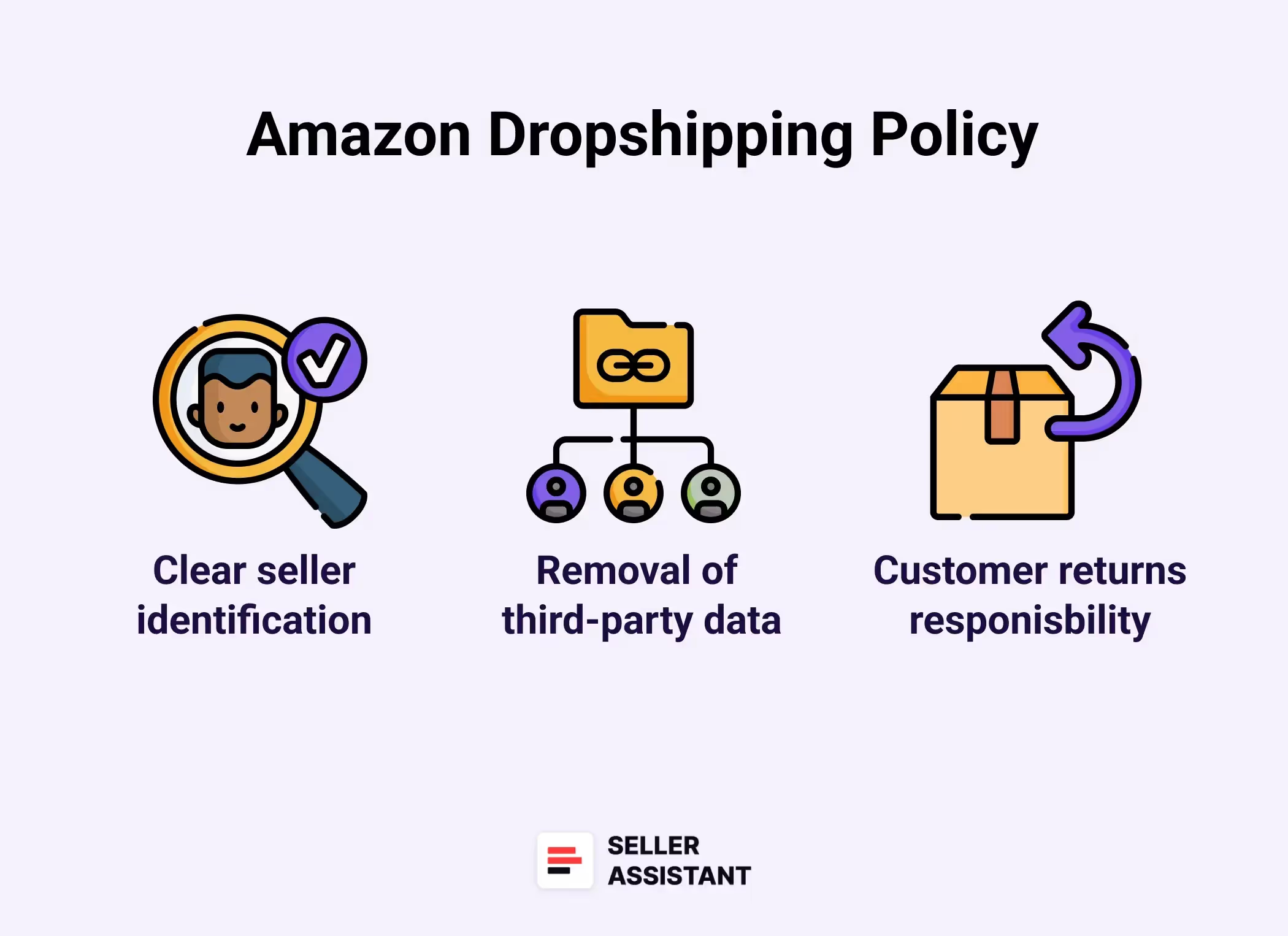
- Seller identification
You must clearly identify yourself as the seller on all packaging slips, invoices, and product information. These should not reference any third-party retailer.
- Removal of third-party branding
Any logos, data, or branding from the supplier or wholesaler must be completely removed from packaging and product documentation before fulfilling an order.
- Handling customer returns
Sellers are responsible for managing returns efficiently and professionally, following Amazon’s standards and timeframes.
Pros and Cons of Dropshipping on Amazon
Amazon dropshipping offers a unique opportunity for sellers, but like any business model, it has both advantages and drawbacks. Here’s a breakdown of the main pros and cons.
Pros

- Low upfront costs
Amazon dropshipping allows you to start selling with minimal investment, as you don’t need to buy inventory upfront. This makes it a great option for sellers with limited capital or those looking to minimize financial risk.
- No inventory management
You can outsource storage, packaging, and shipping to third-party suppliers, freeing you from the hassle of managing physical inventory. This allows you to focus on other business tasks like product research and customer service.
- No pressure to sell inventory quickly
Since dropshippers don’t need to buy or store inventory, they aren't under pressure to sell items immediately. This allows them to wait for more favorable market conditions, enabling them to sell at a higher price for better profits. One such example is when competitors are out of stock and a dropshipper can sell Amazon products at a higher price because there are no other offers.
Cons
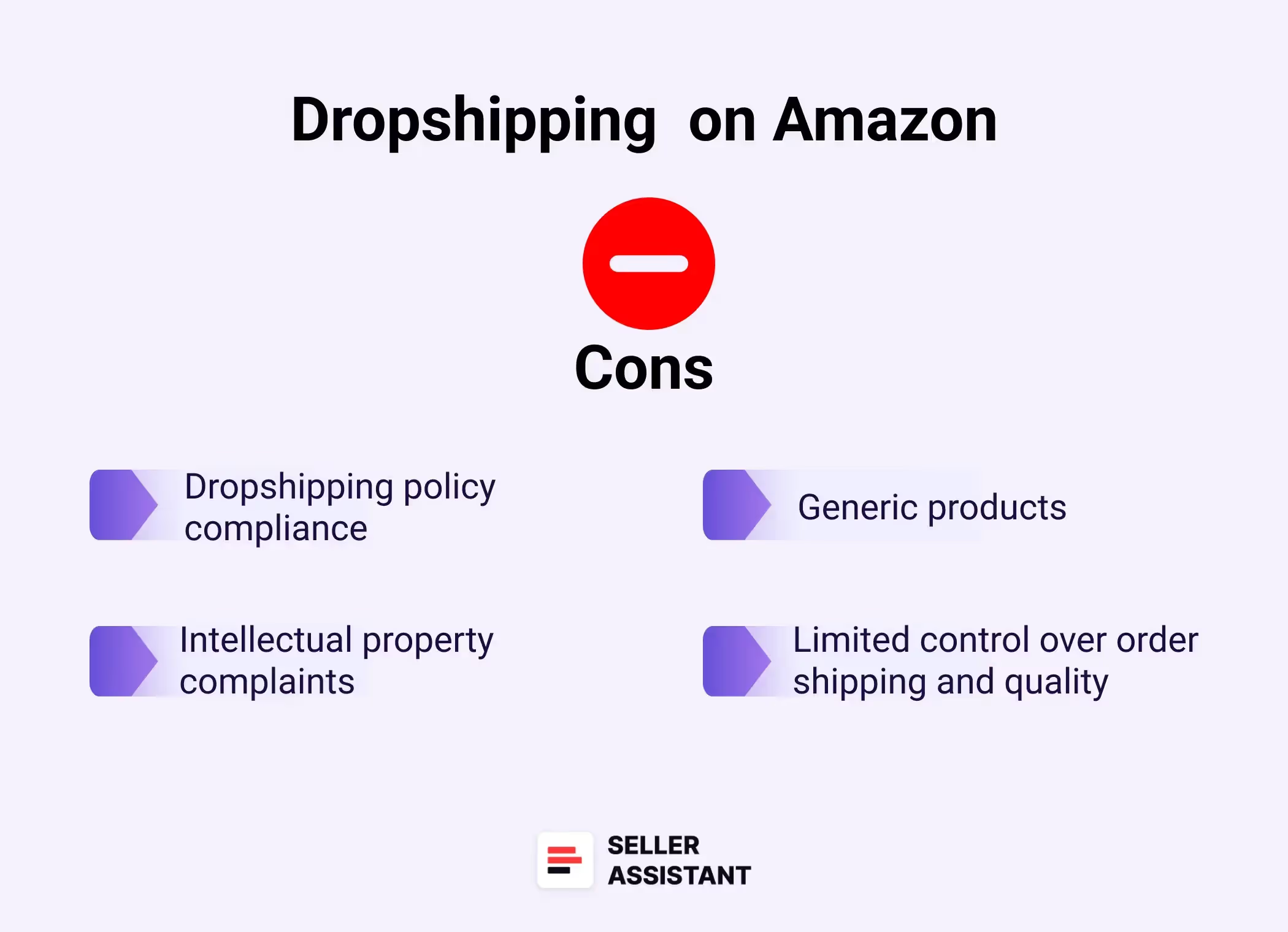
- Dropshipping policy compliance
Amazon requires you to remove supplier branding and issue invoices and packaging in your name, which can be difficult if you don’t handle the products yourself. Failing to comply with these policies can lead to account suspension or other penalties.
- Selling eligibility and restrictions
Reselling products from established brands may pose a risk of intellectual property complaints from those brands if they restrict third-party sales. You must always check your eligibility to sell a brand or product before you agree with the supplier.
This is because Amazon will not allow you to list offers if you are not allowed to sell a brand or product on your account (or if it is restricted and you don’t have approval to sell it). You will not be able to add your offer until you are approved by Amazon.
- Limited control over quality and shipping
Since fulfillment is handled by your supplier, you have little control over the quality of the products or shipping times. This can negatively impact customer satisfaction, leading to negative reviews and increased return rates.
How to Start Amazon Dropshipping?
Starting an Amazon dropshipping business is a straightforward process, but it requires careful planning and attention to detail. To make money from dropshipping you don’t need to invest in products upfront. All you need begin selling is finding a dropshipping deal (a product you can resell on Amazon for a good profit), and agree with a prep center that will repackage products in your name.
However, to succeed, you need to understand the dropshipping workflow and follow essential steps, from opening a seller account to fulfilling customer orders. Below is how the process works and the key steps needed to start your Amazon dropshipping business efficiently and successfully.
How Amazon dropshipping works
In Amazon dropshipping, the seller acts as an intermediary between the customer and the supplier. This method removes the need for the seller to manage inventory or deal with packaging and shipping.
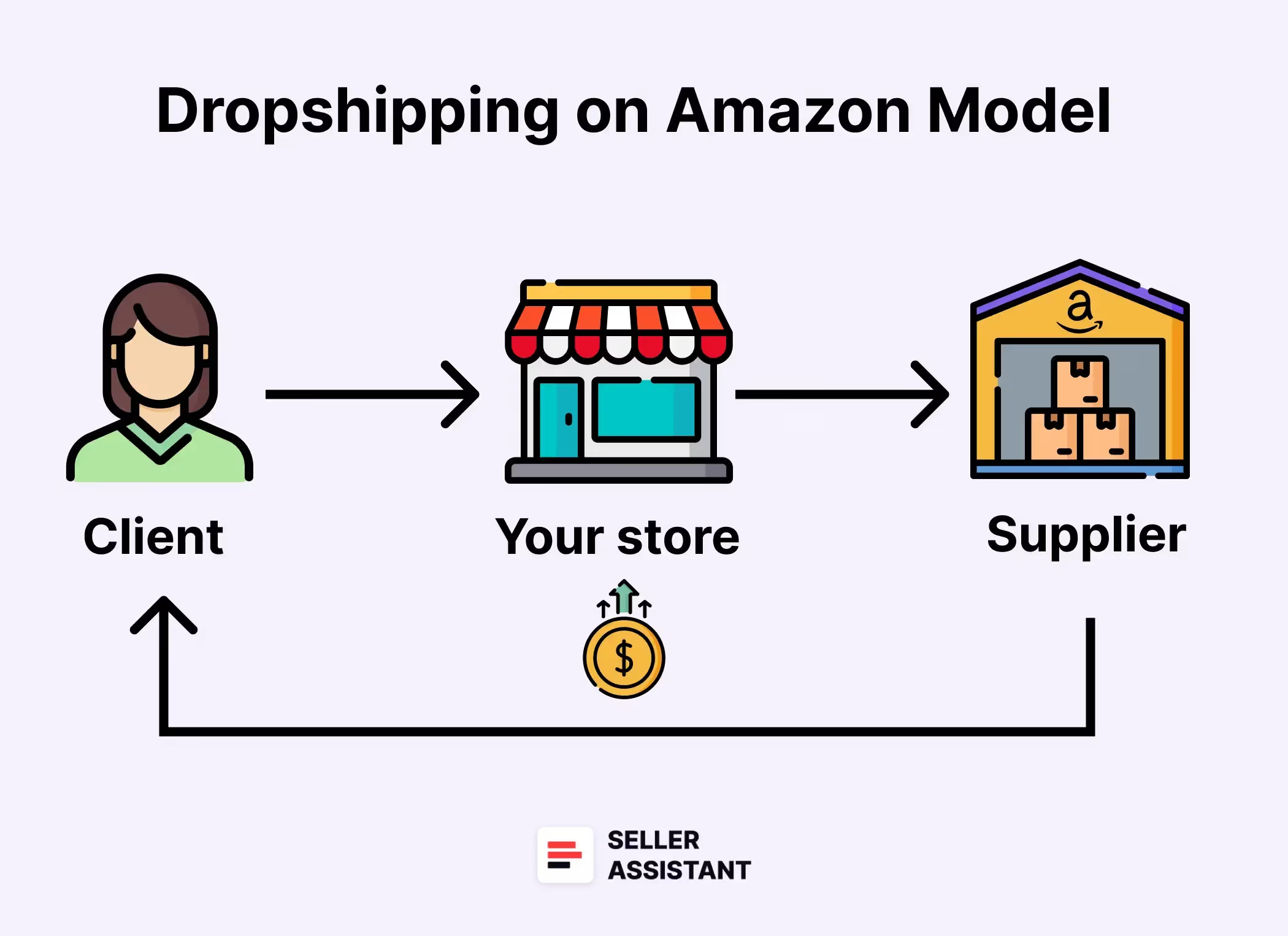
Key players
- Dropshipper
You, the seller, who lists and manages products
- Supplier
The supplier, who stores and ships items
- Amazon buyer
The customer, who makes the purchase
- Amazon
Amazon, the platform facilitating the sale.
Efficient fulfillment
Sellers never handle the products directly. Instead, they rely on suppliers to fulfill customer orders and ensure delivery, or use prep centers to repackage products in accordance with Amazon’s guidelines and ship the order to the customer.
Steps to start dropshipping on Amazon
.avif)
Starting dropshipping on Amazon involves a series of steps to set up and run your business efficiently.
Step 1. Open an Amazon seller account
Begin by registering for an Amazon seller account, which allows you to list and sell products on the platform. Choose between the Individual or Professional selling plan based on your expected sales volume.
Step 2. Find a supplier
Partner with a supplier who meets Amazon’s inventory and shipping standards. Ensure they offer competitive pricing, good product quality, and prompt delivery times.
Step 3. Research and choose a product
The success of your dropshipping business depends on choosing a profitable product. Use product research tools to evaluate demand, competition, and profit margins before making a selection.
Step 4. List the product on Amazon
Once you’ve selected a product, add it to your Amazon seller account. Use the product ASIN and follow the process in Seller Central to create your listing.
Step 5. Receive an order
When a customer purchases your product, Amazon notifies you via your Seller Central account. This triggers the fulfillment process with your supplier.
Step 6. Forward the order to the supplier
Share the order details with your supplier, including the product, quantity, and customer information. The supplier then prepares the order for shipment.
Step 7. Supplier ships the product
- Option 1. Direct shipment to customer
If you've arranged with your supplier, they will ship the order directly to the customer, ensuring the packaging complies with Amazon's guidelines. In this case, you never physically handle the product, and the supplier takes care of the entire fulfillment process.
- Option 2. Shipment to prep center
For sellers managing a large inventory or multiple products, the supplier can ship the products to a prep center. The prep center then repackages the items according to Amazon’s requirements before sending them to the customer.
Step 8. Prep center repackaging (optional)
The supplier ships the product to a prep center, where it is repackaged according to Amazon’s dropshipping rules. Alternatively, if you prefer, you can handle the repackaging yourself to ensure compliance with Amazon's requirements before forwarding the order to the customer.
Step 9. Customer receives the product
The customer receives their order, completing the transaction without any direct involvement from you in handling inventory or shipping.
Related: Amazon FBA for Beginners
Selling on Amazon: How to Make Money?
How to Sell on Amazon for Beginners - Complete Guide
How Much Does It Cost to Dropship on Amazon?
Dropshipping on Amazon requires minimal upfront investment compared to traditional business models, as you only pay the supplier for products after you’ve received payment from the customer. However, there are still some costs to consider when starting your Amazon dropshipping business.
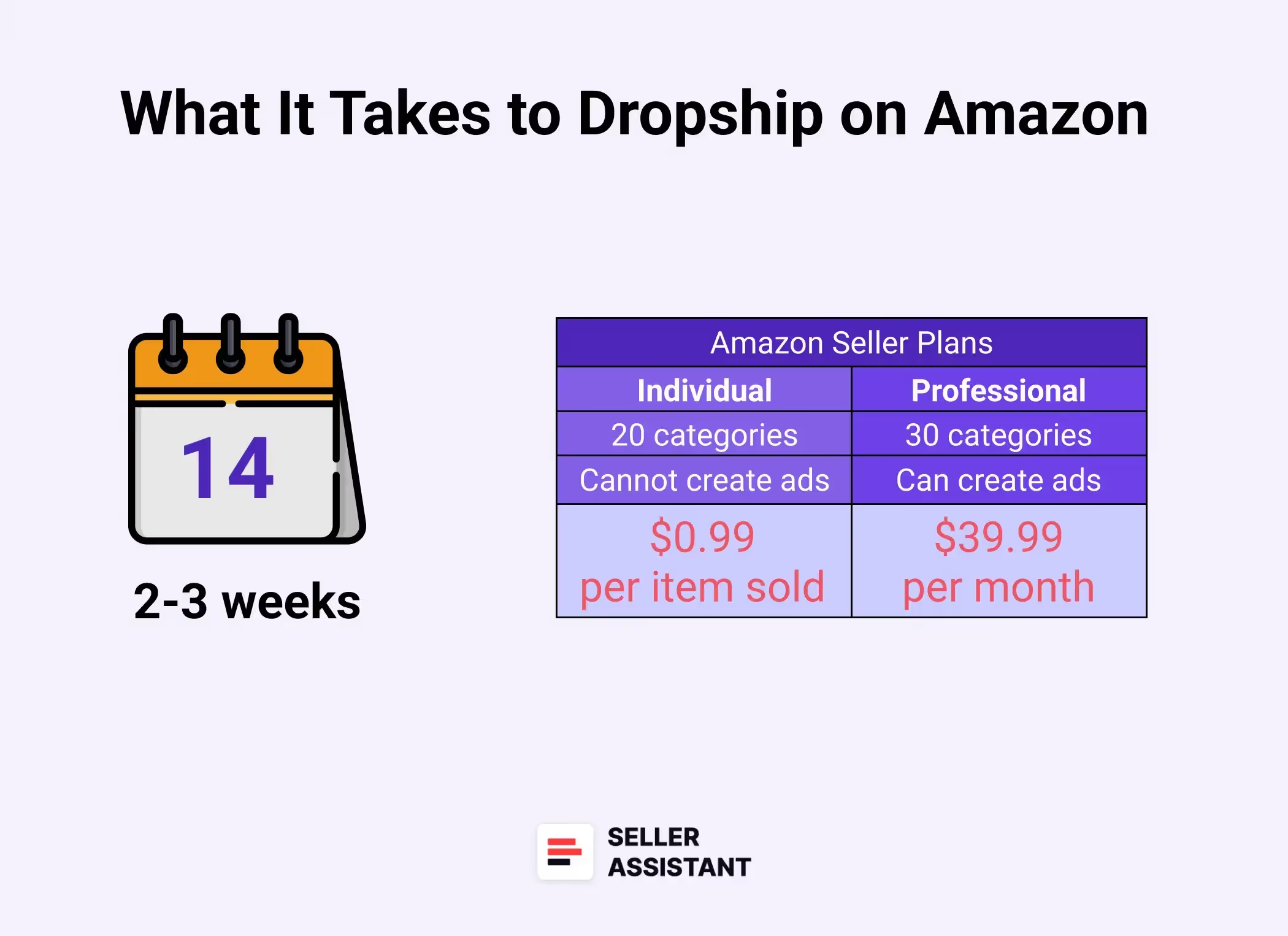
Dropshipping fees
Amazon offers two main account options. The Individual plan charges $0.99 per sale, while the Professional plan costs $39.99 per month and is more cost-effective if you sell more than 40 products per month. The Professional plan also includes additional features for scaling your business.
- Amazon referral fees
The Amazon referral fee is a commission Amazon charges sellers for each item sold through their platform. This fee is based on the total sale price, including the item price, shipping, and any gift-wrapping charges.
The referral fee varies depending on the product category but typically ranges between 8% and 15%. For most categories, the fee is 15%, though some categories like electronics may have lower fees. Each product category has a minimum referral fee per item, which is usually around $0.30.
- Product costs
You will need to pay your supplier for each product sold, which includes the price of the product and any shipping fees from the supplier to the customer. They are deducted from the product selling price on Amazon and paid when the product is sold. The rest is your revenue.
- Other potential costs
Additional expenses might include product sourcing tools, which are essential for finding profitable products. You may also need to budget for prep center fees (optional) and other business-related expenses depending on your specific needs.
- Product sourcing software price example
Seller Assistant, a cost-effective sourcing tool, offers various subscription plans.
- Start: $15.99/month
- Pro: $29.99/month
- Business: $79.99/month.
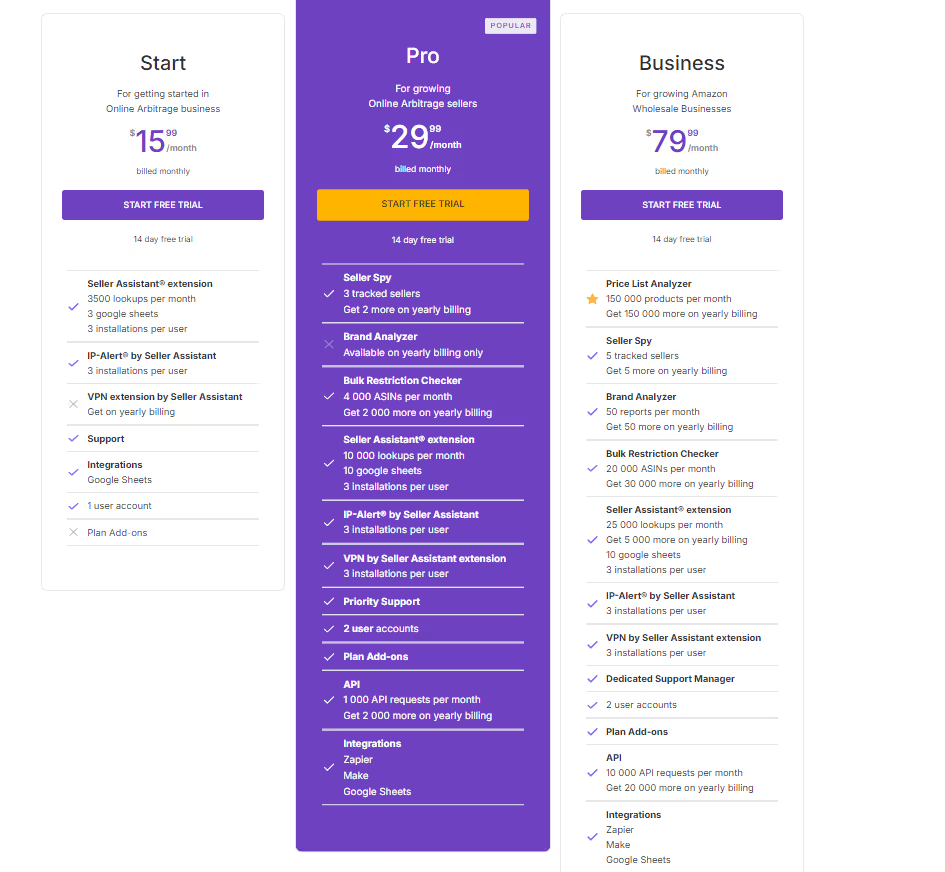
Note. Seller Assistant is a comprehensive product-sourcing software that helps Amazon sellers quickly find high-profit deals. It combines three extensions: Seller Assistant Browser Extension, IP-Alert Chrome Extension by Seller Assistant, and VPN by Seller Assistant, Amazon seller tools: Price List Analyzer, Brand Analyzer, Seller Spy, Bulk Restrictions Checker, Zapier and API integrations, and features: Side Panel View, FBM&FBA Profit Calculator, Quick View, ASIN Grabber, UPC/EAN to ASIN converter, Stock Checker, IP Alert, and Restrictions Checker.
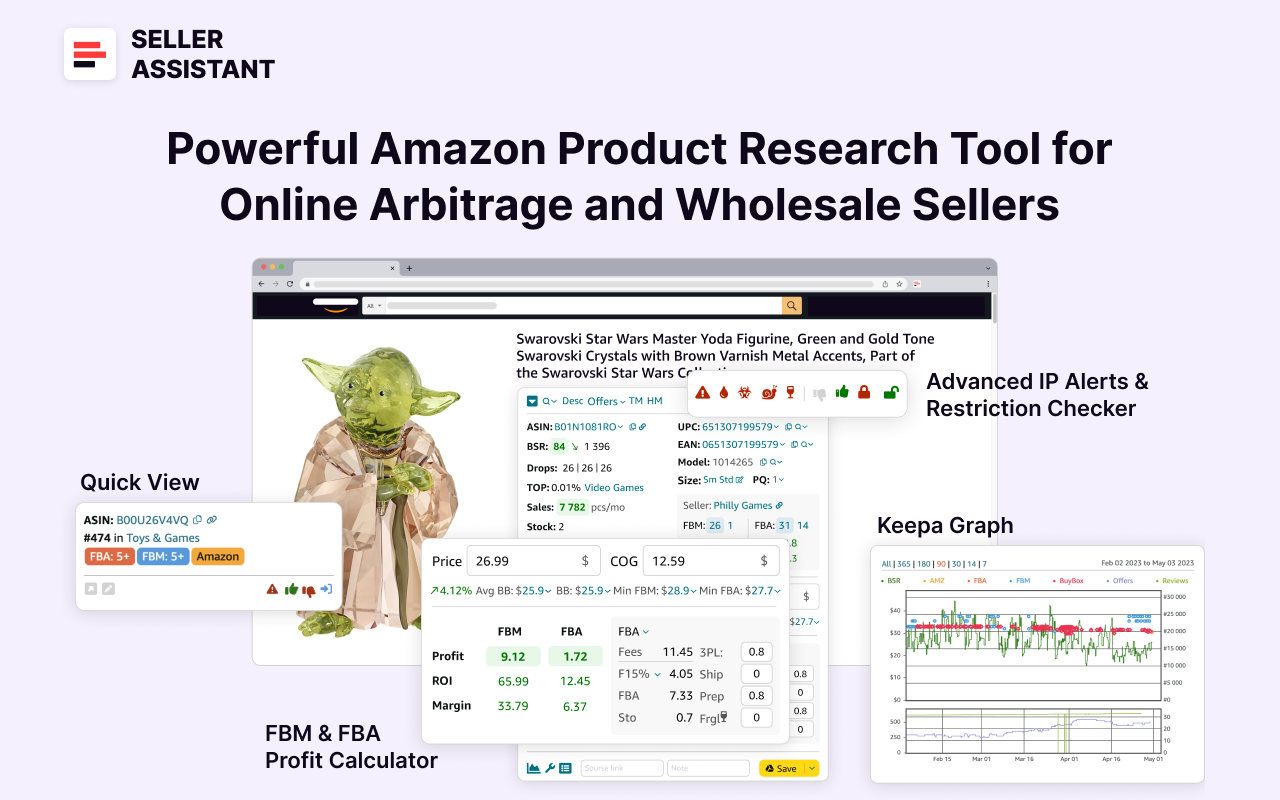
Seller Assistant shows all essential product data on Amazon search, product, and inventory pages, and on any website to help you find high-margin deals. By using this FBA and FBM product sourcing software, you can easily identify products that have the potential to be sold well on Amazon.
Related: Amazon FBA Fees 2025
Seller Assistant Extension Review
3 Strategies to Finding Dropshipping Deals
The key task for a dropshipper is to find profitable deals that don’t have any hidden risks. Here are three effective methods to help you uncover dropshipping deals.
Method 1. Automated sourcing
Automated sourcing, also known as supplier-to-Amazon sourcing, is an efficient strategy for dropshippers looking to scale their business or sell multiple products. It leverages automation tools to match supplier products with listings on Amazon.
- How it works
This method involves scraping product data from supplier websites to identify potential resale opportunities on Amazon. You’ll receive a file with hundreds or thousands of products and use automated tools to assess profitability, saving you time compared to manual research.
- Tools to use
A tool like Seller Assistant’s Price List Analyzer makes this process easier by matching supplier products with Amazon listings. It calculates key metrics like Return on Investment (ROI), Best Sellers Rank (BSR), Buy Box price, Amazon fees, and many other metrics, helping you quickly spot the most profitable deals.
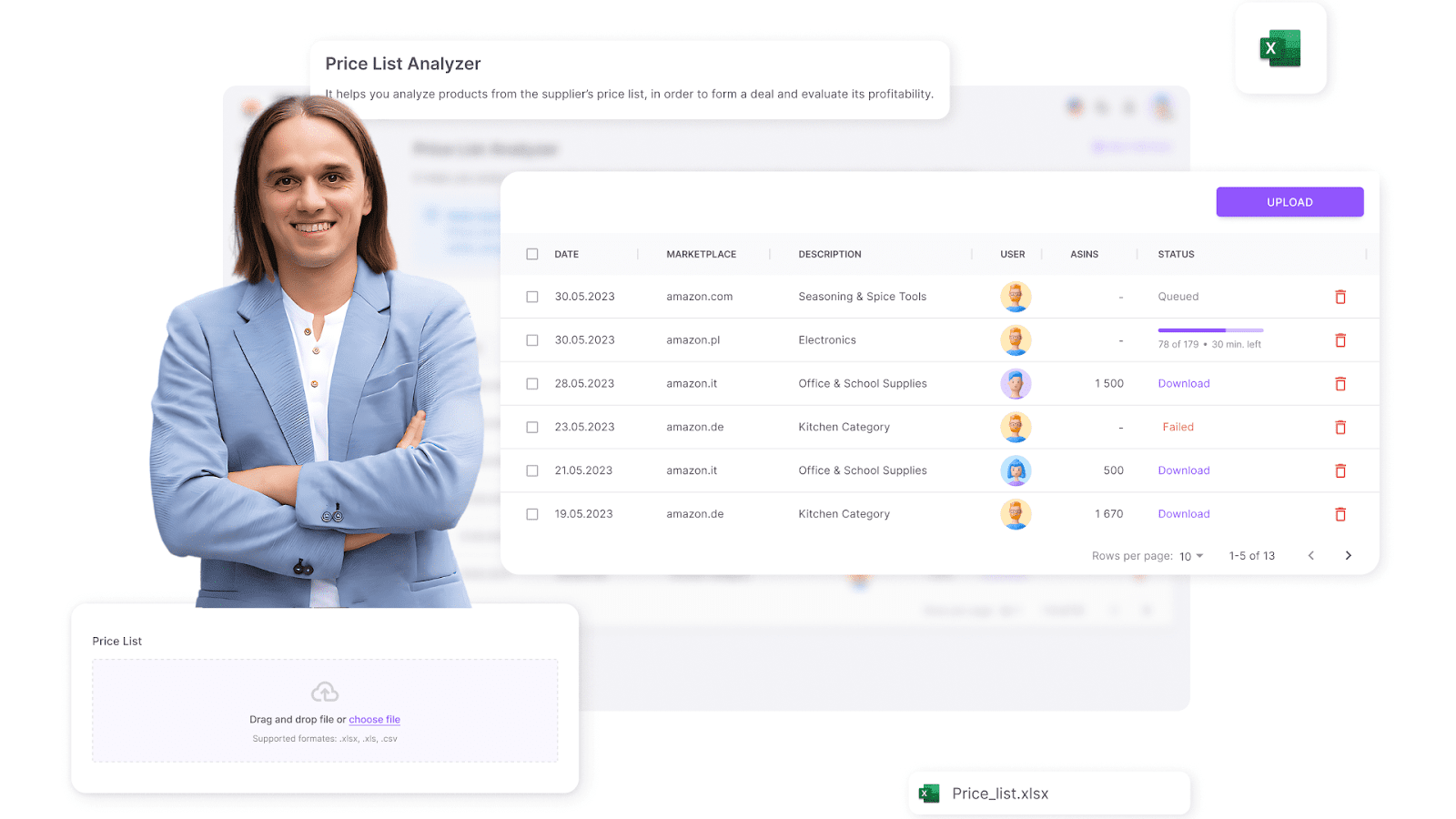
Price List Analyzer data
Product identification and details
- ASIN/Parent ASIN
- Link
- Product image
- Title
- UPC, EAN, GTIN
- Brand
- Manufacturer or brand of the product
- Category
- Model, manufacturer, part number
Sales performance metrics
- BSR (Best Sellers Rank)
- Top BSR
- Sales Estimate (pcs/month)
- Sales Estimate ($/month)
Pricing and profitability
- COG (Cost of Goods)
- Cost of Goods incl. VAT
- Buy Box price
- Break-Even price (FBA/FBM)
- Profit (FBA/FBM)
- ROI (FBA/FBM, %)
- Margin (FBA/FBM, %)
Fulfillment costs
- Total FBA/FBM fees
- FBA fees
- Referral fee
- Storage fees
- Variable Closing Fee
- Inbound shipping costs (FBA)
- Prepare/labeling cost (FBA/FBM)
- Fragile/bubble wrapping (FBA/FBM)
Tax and compliance
- VAT on fees
- Sales tax rate (%)
- Sales tax
- Apply sales tax
- VAT on fees rate (%)
Product restrictions and flags
- Warning
- Oversize flag
- HazMat flag
- Meltable flag
- Fragile flag
- IP complaints flag
- Variation flag
- Set/bundle flag
- Dimensions and Packaging
- Product volume (cu ft/cu cm)
- Package quantity.
Benefits of automated sourcing
- Automated lead identification
This strategy allows dropshippers to analyze large product lists from suppliers quickly, enabling faster business growth.
- Data-driven decision making
Tools like the Price List Analyzer offer essential profitability metrics, reducing guesswork and increasing the chances of selecting profitable products.
Method 2. Independent product sourcing
Independent product sourcing is where dropshippers find popular products on Amazon and then locate suppliers who offer them at a competitive price. This method is perfect for dropshippers who want full control over their product selection process.
- How it works
Start by identifying in-demand products on Amazon through sections like Amazon Best Sellers, Amazon Movers & Shakers, Amazon’s Hot New Releases, and Amazon "Most Wished For". Then, use tools like Seller Assistant’s Side Panel View to search for suppliers and evaluate their pricing and profitability.
- Tools to use
Seller Assistant’s Side Panel View allows you to compare supplier offers with Amazon listings side-by-side. It provides crucial metrics such as Best Sellers Rank, Buy Box price, and profit margins, helping you make informed decisions.

Side Panel View data
- Product title;
- Image;
- ASIN;
- Brand;
- Category;
- Best Sellers Rank (BSR);
- Product flags (hazmat, meltable, fragile, oversized, generic brand, adult, sold by Amazon, IP alert);
- Likes and dislikes;
- Restriction checker (lock icon)
- FBA and FBM seller count;
- Break-even price point (BEP);
- Estimated product sales (Est);
- BuyBox price;
- Cost of Goods (COG, enterable).
- Profit;
- ROI;
- Offers (offer count - total, FBA and FBM; seller, stock, and Buy Box %);
- Variations (rating, share);
- Supplier notes and link;
- Saving to Google Sheets.
Watch: How to check Amazon products on any website| Side Panel View Review
How it works step-by-step
Step 1. Product supplier search
Start by opening the product listing on Amazon and using Seller Assistant’s Lookup Links to find suppliers. Choose your preferred search engine, and the tool will offer relevant supplier options.
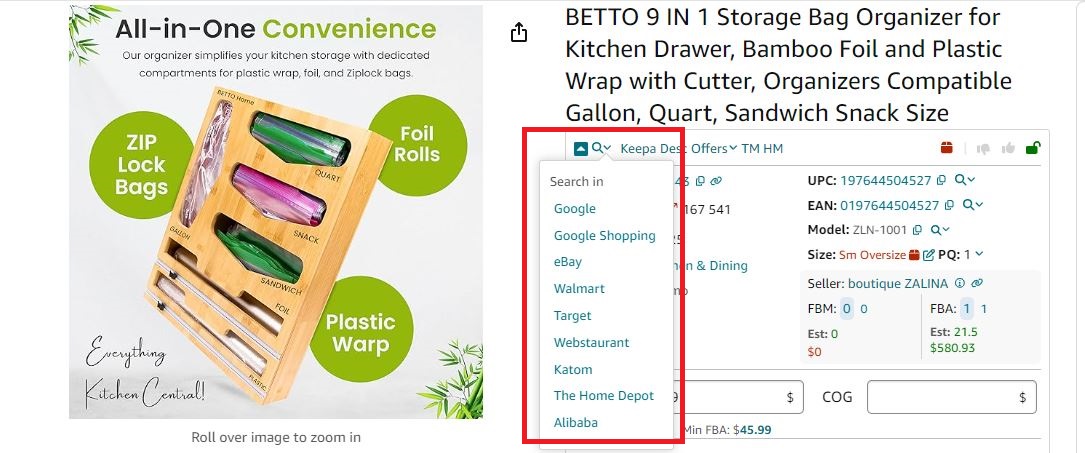
Step 2. Activate Side Panel View
To access the Side Panel View, highlight the product title on the supplier’s website, right-click, and select "Search with Seller Assistant" from the context menu. This tool will then display the product’s offers and profitability metrics.

Step 3. Side-by-side product comparison
After finding a suitable supplier, use Seller Assistant’s Side Panel View to compare the Amazon listing and the supplier’s offer. This allows you to evaluate key metrics side-by-side, helping you decide whether the product is worth sourcing based on the extended research. You must make sure the product meets your custom product research criteria. If it does, you find a lead.
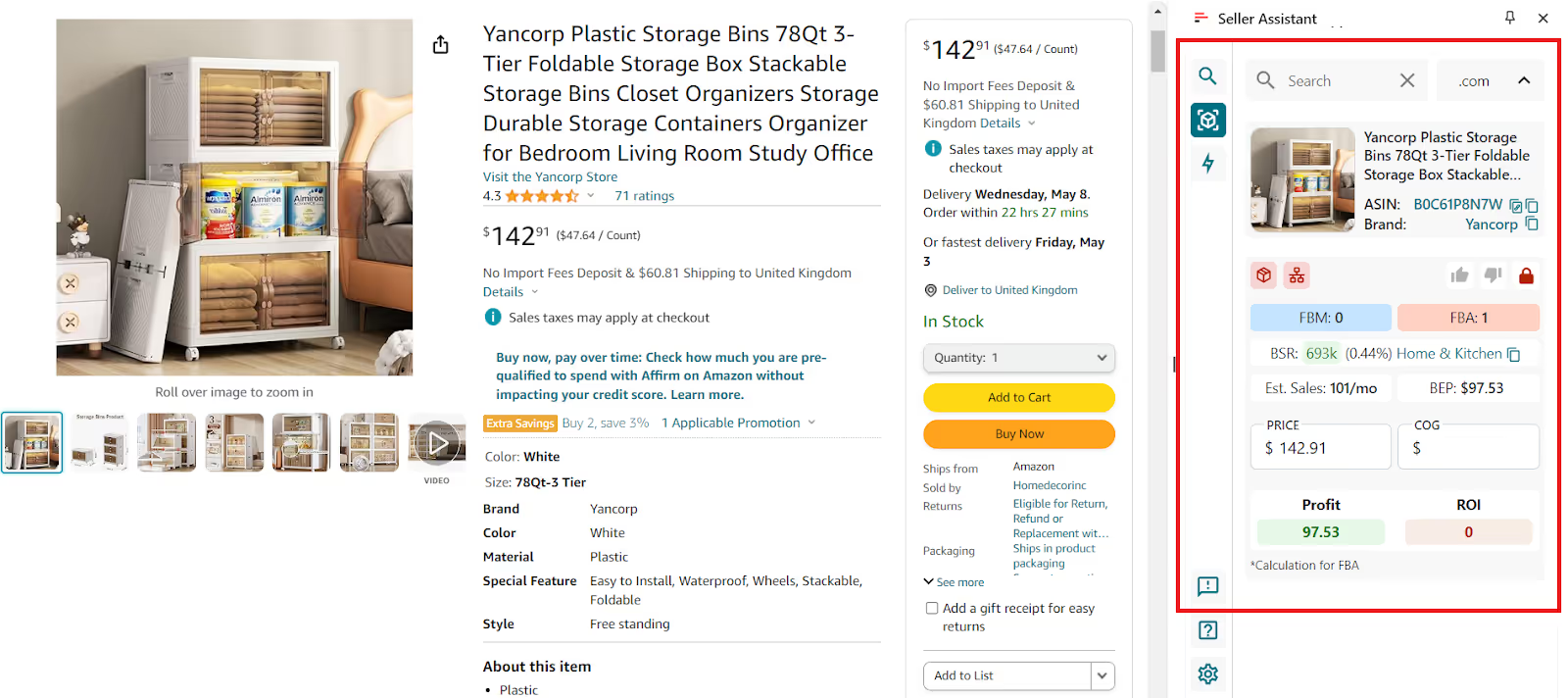
Benefits of independent product sourcing
- No sourcing costs
This method doesn’t require paying for additional sourcing services, allowing you to allocate your budget more effectively.
- Full control
You have complete autonomy over the products you choose, enabling quicker adaptations to market trends and better alignment with your profit goals.
Method 3. Competitor research
Competitor research is a smart strategy for dropshippers who want to gain insights from their rivals and discover new product ideas. By analyzing competitors’ offerings, you can identify market gaps and expand your product lineup.
- How it works
This method involves tracking competitors to identify high-demand products and brands that you might not be selling yet. You can discover new leads by reviewing their newly added products and pricing strategies.
- Tools to use
Seller Assistant’s Seller Spy simplifies competitor research by automatically tracking their product listings. It provides insights into their pricing and product offerings, allowing you to adjust your inventory and pricing strategies accordingly. You simply add a competitor name and download a file with their new products, prices, and other details/

Seller Spy product tracking details
- The date a product was added or removed from competitor offerings;
- The status of each product (added or removed);
- Product image;
- Product ASIN;
- Your competitor's current selling price;
- Direct product links.
Benefits of competitor research
- Automated tracking
Seller Spy automates the process, saving you time and providing real-time data on competitors’ product changes.
- Comprehensive data
You gain access to detailed product information, including images, ASINs, and pricing, helping you make more informed sourcing decisions.
5 Actionable Dropshipping Tips
To succeed in Amazon dropshipping, it's essential to adopt strategies that minimize risks and maximize efficiency. Here are five actionable tips to help you stay ahead.
.avif)
Use a prep center
A prep center can handle packaging and shipping, ensuring your products meet Amazon's requirements. This allows you to focus on other aspects of your business while ensuring compliance with Amazon's policies.
Utilize multiple accounts
Operating several Amazon accounts, whether by registering them under trusted employees or purchasing them, can reduce the risk of losing your entire business if one account is suspended. Diversifying across accounts provides security in case of unexpected bans.
Check restrictions with Bulk Restriction Checker
Use tools like Seller Assistant’s Bulk Restrictions Checker to quickly check selling eligibility for multiple products at once. This tool can also generate downloadable reports, making it easy to track restrictions and selling eligibility. It will show a green open lock if you can sell a brand or product on your Amazon account, a red closed lock if it’s restricted, and a red closed lock with an exclamation mark if you can’t sell it.
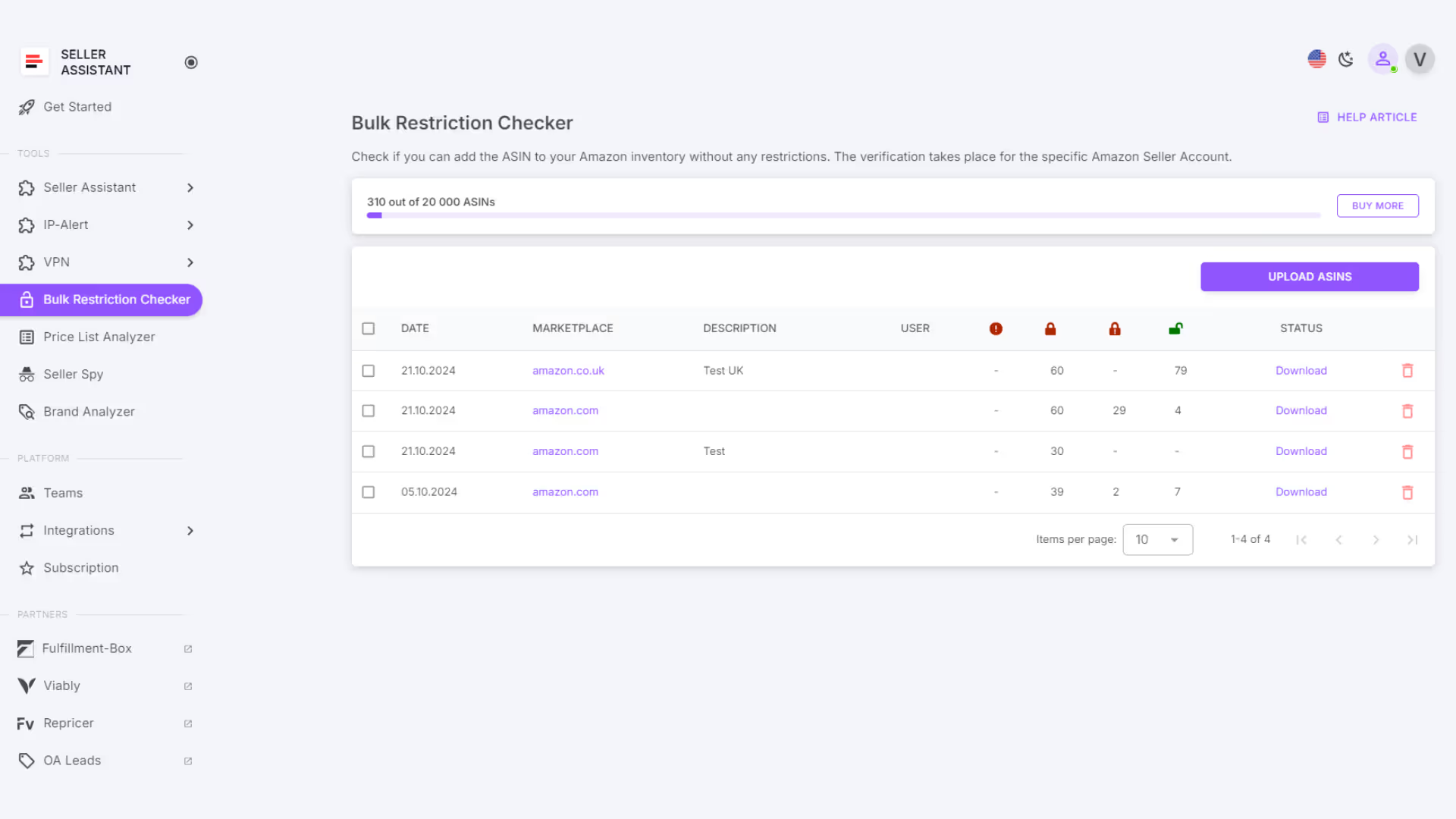
Don’t price low
Instead of lowering prices to compete, focus on finding multiple profitable deals. Wait for competitors to run out of stock, then raise prices to a more profitable level.
Plan for customer service
Since you won’t handle the products directly, ensure your supplier’s return policies align with Amazon’s standards. Create a reliable system to address customer inquiries and issues, which will help maintain positive reviews and customer satisfaction.
Is Dropshipping Right for You?
Dropshipping offers a flexible and low-risk way to start an online business, but it’s not for everyone. To determine if this business model is the right fit for you, consider the following factors.
Your experience level
If you’re new to selling online, dropshipping is a good option as it is generally simpler to manage compared to other models. It requires less knowledge of inventory management and shipping logistics, making it ideal for beginners.
Your budget
Dropshipping is budget-friendly because you don’t need to purchase inventory upfront. This allows you to start with minimal financial investment, making it a low-risk business model.
Your time commitment
If you have limited time to dedicate to your business, dropshipping might be a better fit as it requires less setup and daily management. You don’t have to deal with warehousing or shipping, allowing you to focus on other areas of your business.
Your goals
If your primary goal is to build a low-risk business with minimal upfront costs, dropshipping is a strong option. While it may not yield high profits quickly, it offers a flexible and scalable path to gradual growth.
Related: Amazon Inventory Management
The Best Amazon Online Arbitrage Tool — Seller Assistant
Amazon Wholesale: How to Sell Wholesale on Amazon
FAQ
How much does it cost to dropship with Amazon?
The main costs include your Amazon seller account (either $0.99 per sale with the Individual plan or $39.99 per month with the Professional plan) and Amazon referral fees, which typically range from 8% to 15% of each sale. You’ll also need to pay your supplier for each product sold, plus any optional costs for tools like Seller Assistant and prep centers.
Is dropshipping with Amazon risky?
While Amazon dropshipping offers low upfront costs, it does come with risks like potential account suspension if you violate Amazon’s dropshipping policies. Additionally, you rely heavily on third-party suppliers, which can affect shipping times and product quality, impacting your customer reviews.
How much does it cost to start an Amazon dropshipping business?
Starting costs are low, as you don’t need to buy inventory upfront. Aside from the Amazon seller account fees, you may incur costs for product sourcing tools, such as Seller Assistant (ranging from $15.99 to $79.99 per month), and optional services like prep centers.
Does Amazon allow dropshipping?
Yes, Amazon allows dropshipping, but only if sellers follow strict guidelines. You must be listed as the seller on all packaging and invoices, and any third-party supplier branding must be removed.
Is Amazon dropshipping profitable?
Amazon dropshipping can be profitable if you choose products with high demand and low competition while keeping fees in mind. However, profit margins can be thin due to Amazon’s fees and reliance on third-party suppliers.
Final Thoughts
In conclusion, Amazon dropshipping in 2025 remains a viable and low-risk option for aspiring entrepreneurs looking to break into e-commerce. By following Amazon’s dropshipping policies, finding reliable suppliers, and leveraging the right tools to streamline your operations, you can build a profitable business.
Seller Assistant is an all-in-one product sourcing software offering all the features vital for product sourcing. It combines three extensions: Seller Assistant Extension, IP Alert, and VPN by Seller Assistant, tools: Price List Analyzer, Seller Spy, Bulk Restrictions Checker, and API integrations, and features: Side Panel View, FBM&FBA Profit Calculator, Quick View, ASIN Grabber, UPC/EAN to ASIN converter, Stock Checker, and other features that help quickly find high-profit deals. Seller Assistant also offers integration with Zapier allowing to create custom product sourcing workflows.
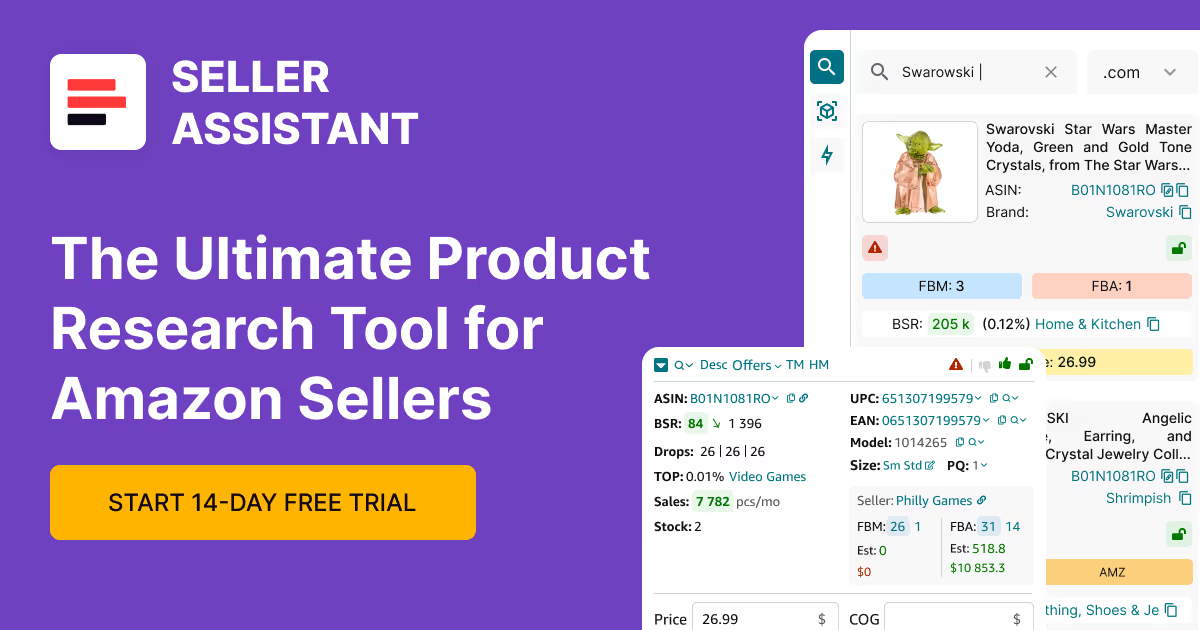
.svg)













